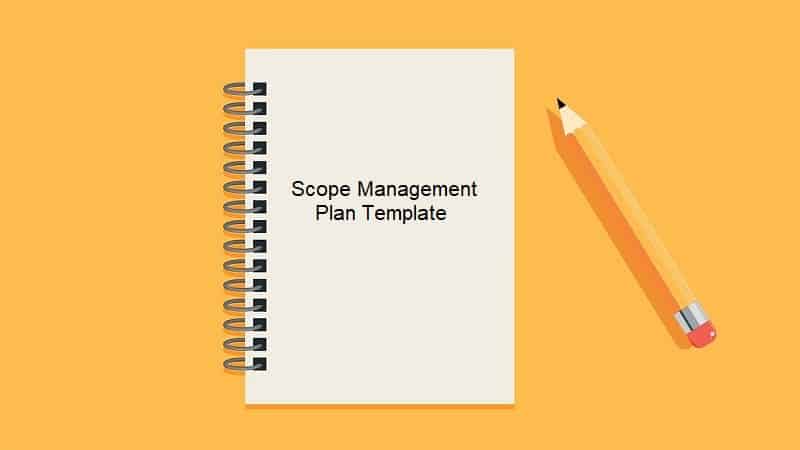Download this free Scope Management Plan template and use it for your new project. Scroll down to the bottom of the page for the download link.
1 Introduction
Scope Management is the collection of processes used to ensure that the project includes all the tasks required to complete the project while excluding all work which is out of scope. The Scope Management Plan details how the project scope will be defined, developed, and verified. The plan clearly defines who is responsible for managing the project’s scope and acts as a guide for managing and controlling the scope.
Project Scope Management follows a five step process: Collect Requirements, Define Scope, Create WBS, Verify Scope, and Control Scope.
- Collect Requirements – This first step is the process by which we define and document the requirements needed to meet all project objectives. The foundation of this process is the project charter and stakeholder register. From these, the team can identify key business drivers and high level solution vision requirements, collectively discuss details associated with meeting each requirement, conduct interviews and follow-on discussions to clarify the requirements, and document the requirements in sufficient detail to confirm consistent expectations measure them once the project begins the execution phase. This documentation also serves as an input to the next step in the process which is to define scope.
- Define Scope – This step is critical to project success as it requires the development of a detailed project/product description to include deliverables, assumptions, and constraints and establishes the framework within which project work must be performed.
- Create Work Breakdown Structure – This process breaks project deliverables down into progressively smaller and more manageable components which, at the lowest level, are called work packages. This hierarchical structure allows for more simplicity in scheduling, costing, monitoring, and controlling the project.
- Verify Scope – This is the process by which the project team receives a formalized acceptance of all deliverables baselined with the sponsor and/or customer.
- Control Scope – This is the process of monitoring/controlling the project/product scope as well as managing any changes in the scope baseline. Changes may be necessary to the project scope but it is imperative they are controlled and integrated in order to prevent scope creep.
The Scope Management Plan provides the scope framework for [PROJECT NAME]. This plan documents the scope management approach, roles and responsibilities as they pertain to project scope, scope definition, verification and control measures, scope change control, and the project’s work breakdown structure. Any project communication which pertains to the project’s scope should adhere to the Scope Management Plan.
The objective of [PROJECT NAME] is the implementation of a new software product which will be used to track the company’s finances and improve various financial processes. This includes design of the software, all programming and coding, and testing/validation of the software. No external resources or outsourcing are anticipated for this project.
2 Scope Management Approach
It is important to clearly define and document in detail the approach to managing the project’s scope. This section provides a summary of the Scope Management Plan and addresses the following:
- Authorities and responsibilities for scope management
- Scope definition process (i.e. Scope Statement, WBS, WBS Dictionary, Statement of Work, etc.)
- Scope measurement and verification (i.e. Quality Checklists, Scope Baseline, Work Performance Measurements, etc.)
- Scope change process (who initiates, who authorizes, etc.)
- Acceptance and approval of project deliverables related to project scope
For [PROJECT NAME], scope management will be the responsibility of the Project Director. The scope for this project is defined by the Scope Statement, Work Breakdown Structure (WBS) and WBS Dictionary. The Project Director, Sponsor and Stakeholders will establish and approve documentation for measuring project scope which includes deliverable quality checklists and work performance measurements. Proposed scope changes may be initiated by the Project Director, Stakeholders or any member of the project team. All change requests will be submitted to provide estimate and impact to schedule and costs if any to the Project Director who will then evaluate the requested scope change. Upon acceptance of the scope change request the Project Director will submit the scope change request to the Change Control Board and Project Sponsor for acceptance. Upon approval of scope changes by the Change Control Board and Project Sponsor the Project Director will update all project documents and communicate the scope change to all stakeholders. Based on feedback and input from the Project Director and Stakeholders, the Project Sponsor is responsible for the acceptance of the final project deliverables and project scope.
3 Roles and Responsibilities
In order to successfully manage a project’s scope, it is important to clearly define all roles and responsibilities for scope management. This section should define the role of the Project Director, Project Team, Stakeholders and other key persons who are involved in managing the scope of the project. It should state who is responsible for scope management and who is responsible for accepting the deliverables of the project as defined by the project’s scope. Any other roles in scope management should also be stated in this section.
The Project Director, Sponsor and project team will all play key roles in managing the scope of this project. As such, the Project Sponsor, Project Manager, and team members must be aware of their responsibilities in order to ensure that work performed on the project is within the established scope throughout the entire duration of the project. The table below defines the roles and responsibilities for the scope management of [PROJECT NAME].
| Role | Description |
| Project Sponsor | Provides executive team approval and sponsorship for the project. Has budget ownership for the project and is the major stakeholder and recipient for the project deliverables. |
| Project Director | Provides overall management to the project. Accountable for establishing a Project Charter, developing and managing the work plan, securing appropriate resources and delegating the work and insuring successful completion of the project. All project team members report to the project manager. Handles all project administrative duties, interfaces to project sponsors and owners and has overall accountability for the project. |
| Steering Committee | Provide assistance in resolving issues that arise beyond the project manager’s jurisdiction. Monitor project progress and provide necessary tools and support when milestones are in jeopardy. |
| Stakeholder | Key provider of requirements and recipient of project deliverable and associated benefits. Deliverable will directly enhance the stakeholders’ business processes and environment. Majority of stakeholders for this project will be agency leads, CIO’s, and project management representatives. |
| Team Member | Working project team member, who analyzes, designs and ultimately improves or replaces the business processes. This includes collaborating with teams to develop high level process designs and models, understanding best practices for business processes and partnering with team members to identify appropriate opportunities, challenging the old rules of the business and stimulating creating thinking, and identifying organizational impact areas. |
Table 1: Roles and responsibilities of scope management
4 Scope Definition
The scope definition section details the process of developing a detailed description of the project and its deliverables. This can only be completed after the requirements have been identified and defined during the requirements definition process.
During the requirements definition process, the Requirements Management Plan and the Requirements Traceability Matrix were created. When defining the project scope, these documents should be used as reference.
This section should explain the process followed to develop the detailed description of the project and its deliverables. If other documents such as the Project Charter, Preliminary Project Scope Statement or Requirements Documentation were used, they should be identified in this section. The scope definition process should be tied back to the requirements definition as the projects’ scope answers the requirements for the project.
This section should also be used document the tools and techniques used to define the project scope such as expert judgment, product analysis, alternatives identification, or facilitated workshops.
The scope for [PROJECT NAME] was defined through a comprehensive requirements collection process. First, a thorough analysis was performed on the agency’s current software applications based on employee and user feedback. From this information, the project team developed the project requirements documentation, the requirements management plan, and the requirements traceability matrix for what the new software application must accomplish.
The project description and deliverables were developed based on the requirements collection process and input from subject matter experts in software design, technical support, programming and business applications. This process of expert judgment provided feedback on the most effective ways to meet the original requirements of providing a new software platform from which the company can improve its financial tracking and internal financial processes.
5 Project Scope Statement
The project scope statement details the project’s deliverables and the work necessary to create these deliverables. The Project Scope Statement should contain the following components:
- Product Scope Description (In Scope) – Describes what the project will accomplish
- Product Completion/Acceptance Criteria – Describes what requirements must be met in order for the project to be accepted as complete
- Risk Assessment- Describe the top two or three projects risk and a high-level mitigation plan. This brief assessment will be expanded in the formal Risk Management Plan.
- Project Deliverables – Detailed list of deliverables the project will result in
- Project Exclusions (Out of Scope) – Description of work that is not included in the project and outside of the scope
- Project Constraints – Lists limits on resources for time, money, manpower, or equipment (capital)
- Dependency Linkages- In some cases, one project may be dependent upon another project’s deliverables; this linkage needs to be identified and its progress monitored. In other cases, a project may be dependent upon information from several agencies; the tasks and activities of the information gathering process need to be monitored.
- Measures of Project Success- This section describes the metrics that will be used on the project to determine how success will be measured. Such metrics might include how to measure customer satisfaction or might state what “user friendly” system is.
- Project Assumptions – Describes the list of assumptions the project team and stakeholders are working under to complete the project
The [PROJECT NAME] scope statement provides a detailed description of the project, deliverables, constraints, exclusions, assumptions, and acceptance criteria. Additionally, the scope statement includes what work should not be performed in order to eliminate any implied but unnecessary work which falls outside the of the project’s scope.
[PROJECT NAME] includes the design, programming, and testing of a new software application for tracking the company’s finances. The deliverables for this project are a completed software application for finance tracking with the flexibility to modify and expand the application as necessary in the future. This project will be accepted once the new software has been successfully tested in each department and has been shown to be compatible with the company’s current information technology (IT) infrastructure. This project does not include ongoing operations and maintenance of the software. Only internal personnel and resources may be used for this project. Additionally, the project is not to exceed 180 days in duration or $450,000 in cost. Assumptions for this project are that support will be provided by the project sponsor and all department managers and that adequate internal resources are available for the successful completion of this project.
6 Work Breakdown Structure
The Work Breakdown Structure (WBS) and Work Breakdown Structure Dictionary are key elements to effective scope management. This section should discuss how the project scope is to be subdivided into smaller deliverables in the WBS and WBS Dictionary and how these smaller components are managed during the life of the project.
For more effective management, the work required to complete [PROJECT NAME] will be subdivided into individual work packages not to exceed 40 hours of work. This will allow the Project Director to more effectively manage the project’s scope as the project team works on the tasks necessary for project completion. The project is broken down into three phases: the design phase, the programming phase, and the testing phase. Each of these phases is then subdivided further down to work packages that are estimated to require no more than 40 hours of work and no less than 4 hours of work.
7 Scope Verification
Scope verification should describe how the deliverables will be verified against the original scope and how they will be formally accepted. For best results, the project deliverables should be reviewed and approved by the customer throughout the lifecycle of the project and not held back as a single deliverable at the end of the project.
As [PROJECT NAME] progresses, the Project Director will verify interim project deliverables against the original scope as defined in the scope statement, WBS and WBS Dictionary. Once the Project Director verifies that the scope meets the requirements defined in the project plan, the Project Director and Sponsor will meet for formal acceptance of the deliverable. During this meeting the Project Director will present the deliverable to the Project Sponsor for formal acceptance. The Project Sponsor will accept the deliverable by signing a project deliverable acceptance document. This will ensure that project work remains within the scope of the project on a consistent basis throughout the life of the project.
| Milestone | In Scope | Out Scope | Date | Deliverable | |
Table 2: Milestone
8 Scope Control
Scope control is the process of monitoring the status of the scope of the project. This section also details the change process for making changes to the scope baseline.
The Project Director and the project team will work together to control of the scope of [PROJECT NAME]. The project team will leverage the WBS Dictionary by using it as a statement of work for each WBS element. The project team will ensure that they perform only the work described in the WBS dictionary and generate the defined deliverables for each WBS element. The Project Director will oversee the project team and the progression of the project to ensure that this scope control process is followed and progress is reported through Project Scope measurements tools.
9 Scope Change
If a change to [PROJECT NAME] scope is needed, the process for recommending and estimating changes to the scope of the project must be carried out. Any project team member or Sponsor can request changes to the project scope. All change requests must be submitted to the Project Director in the form of a project change request document. The Project Director will then review the suggested change to the scope of the project. The Project Director will then either reject the change request if it does not apply to the intent of the project, or convene a Change Control meeting between the project team and Sponsor to review the change request further and perform an impact assessment of the change. If the change request receives initial approval by the Project Director and Sponsor, the Project Director will then formally submit the change request to the Change Control Board. If the Change Control Board approves the scope change the Project Sponsor will then formally accept the change by signing the project change control document. Upon acceptance of the scope change by the Change Control Board and Project Sponsor the Project Director will update all project documents and communicate the scope change to all project team members’ stakeholders.
Click here to download Scope Management Plan template.




